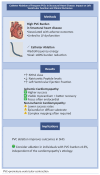Catheter Ablation of Frequent PVCs in Structural Heart Disease: Impact on Left Ventricular Function and Clinical Outcomes
- PMID: 40564207
- PMCID: PMC12191265
- DOI: 10.3390/biomedicines13061488
Catheter Ablation of Frequent PVCs in Structural Heart Disease: Impact on Left Ventricular Function and Clinical Outcomes
Abstract
Background: Frequent premature ventricular complexes (PVCs) are associated with adverse outcomes in patients with structural heart disease (SHD), including increased risk of mortality and impaired left ventricular ejection fraction (LVEF). While radiofrequency ablation (RFA) of idiopathic PVCs is well established, its role in patients with SHD remains less clear. Objective: To review the evidence on the efficacy of RFA for PVC suppression in patients with SHD, specifically evaluating its impact on LVEF and clinical outcomes. Methods: A review of the literature was conducted using PubMed and the Cochrane Library, focusing on studies published after 2010 that included adult patients with SHD and a PVC burden >4% on 24 h Holter monitoring. Studies including patients with presumed PVC-induced cardiomyopathy without underlying SHD were excluded. Key outcomes were LVEF recovery, functional status, and procedural success rates. Results: In ischemic cardiomyopathy, RFA reduced PVC burden significantly and resulted in modest but significant LVEF improvement. In non-ischemic cardiomyopathy, successful ablation improved LVEF by 8-12% on average and enhanced NYHA class. Across mixed cohorts, patients with sustained PVC suppression showed significant improvements in LVEF, functional status, which, in many cases, removed the indication for implantable cardioverter-defibrillators. Notably, procedural success rates ranged from 60 to 94%, and the high baseline PVC burden (>13-20%) consistently predicted LVEF recovery regardless of SHD etiology. Conclusions: RFA of frequent PVCs in patients with SHD leads to meaningful improvements in systolic function and symptoms, particularly in those with high PVC burden. These benefits are seen across ischemic and non-ischemic substrates, although procedural complexity and recurrence rates may be higher. PVC burden, rather than SHD presence alone, should guide patient selection for ablation.
Keywords: ablation; ischemic cardiomyopathy; non-ischemic cardiomyopathy; premature ventricular contraction; structural heart disease.
Conflict of interest statement
The authors declare no conflicts of interest.
Figures

Similar articles
-
Prevalence of frequent premature ventricular contractions and left-ventricular systolic dysfunction in patients receiving Holter monitoring.J Cardiovasc Electrophysiol. 2025 Jan;36(1):54-61. doi: 10.1111/jce.16478. Epub 2024 Oct 24. J Cardiovasc Electrophysiol. 2025. PMID: 39445764 Free PMC article.
-
Radiofrequency catheter ablation for the treatment of idiopathic premature ventricular contractions originating from the right ventricular outflow tract: a systematic review and meta-analysis.Pacing Clin Electrophysiol. 2014 Jan;37(1):73-8. doi: 10.1111/pace.12243. Epub 2013 Aug 26. Pacing Clin Electrophysiol. 2014. PMID: 23980900
-
Catheter Ablation vs Antiarrhythmic Drug Therapy for Treatment of Premature Ventricular Complexes: A Systematic Review.JACC Clin Electrophysiol. 2023 Jun;9(6):873-885. doi: 10.1016/j.jacep.2023.01.035. Epub 2023 Mar 22. JACC Clin Electrophysiol. 2023. PMID: 37380322
-
Development of an electrocardiographic prediction model for outflow tract idiopathic premature ventricular contraction with decreased left ventricular ejection fraction.Eur J Med Res. 2025 Jul 1;30(1):532. doi: 10.1186/s40001-025-02790-2. Eur J Med Res. 2025. PMID: 40597382 Free PMC article.
-
Beta-blockers in patients without heart failure after myocardial infarction.Cochrane Database Syst Rev. 2021 Nov 5;11(11):CD012565. doi: 10.1002/14651858.CD012565.pub2. Cochrane Database Syst Rev. 2021. PMID: 34739733 Free PMC article.
References
-
- Maggioni A.P., Zuanetti G., Franzosi M.G., Rovelli F., Santoro E., Staszewsky L., Tavazzi L., Tognoni G. Prevalence and prognostic significance of ventricular arrhythmias after acute myocardial infarction in the fibrinolytic era. GISSI-2 results. Circulation. 1993;87:312–322. doi: 10.1161/01.CIR.87.2.312. - DOI - PubMed
-
- Echt D.S., Liebson P.R., Mitchell L.B., Peters R.W., Obias-Manno D., Barker A.H., Arensberg D., Baker A., Friedman L., Greene H.L., et al. Mortality and morbidity in patients receiving encainide, flecainide, or placebo. The Cardiac Arrhythmia Suppression Trial. N. Engl. J. Med. 1991;324:781–788. doi: 10.1056/NEJM199103213241201. - DOI - PubMed
-
- Boas R., Thune J.J., Pehrson S., Køber L., Nielsen J.C., Videbæk L., Haarbo J., Korup E., Bruun N.E., Brandes A., et al. Prevalence and prognostic association of ventricular arrhythmia in non-ischaemic heart failure patients: Results from the DANISH trial. Europace. 2021;23:587–595. doi: 10.1093/europace/euaa341. - DOI - PubMed
-
- Milaras N., Dourvas P., Doundoulakis I., Sotiriou Z., Nevras V., Xintarakou A., Laina A., Soulaidopoulos S., Zachos P., Kordalis A., et al. Noninvasive electrocardiographic risk factors for sudden cardiac death in dilated ca rdiomyopathy: Is ambulatory electrocardiography still relevant? Heart Fail Rev. 2023;28:865–878. doi: 10.1007/s10741-023-10300-x. - DOI - PMC - PubMed
Publication types
LinkOut - more resources
Full Text Sources

